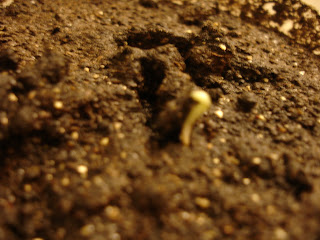




This entry is about survival of the fittest and variability in genes.
A while ago I came to the realization that 1. Plant offspring are very diverse, and 2. Some plants are just not fitted for survival.
This is how it happened:
A few weeks ago, I lost a bean plant that was the offspring of another bean plant that died. They both looked very unhealthy. I was at first sad that the offspring bean died.
In the past, I have grown things on an individual basis (a few beans, a few avocados). With the growing of many tomatoes and many peppers, and now many avocados, I was able to see the differences in health among plants.
The first thing I noticed was that one of the avocado plants that sprouted didn't look good. Its leaves were pale and drooped, and soon started to brown at the tips (like some of the other avocado plants). What distinguished this plant was that the browning spread throughout the leaves, even until one of the leaves became completely dark and wilted. The conditions that I was growing this one were identical to the others' conditions. The conclusion I drew was that this avocado was simply of bad genetic material.
Shortly after, I started noticing that the tomatoes also varied in their healths. Some of them grew to be large but then died, even though they are side-by-side with sibling tomatoes, in the same conditions.
Similarly, all of the pepper plants came from the same parent plant, and are grown in identical conditions. Despite this, some of the pepper plants look pretty bad, while others look good. I concluded from this that there is a lot of variability in the genes of new plants; on average they resemble the parent plant, but they will be distributed in all directions of it.
The benefit of the variability is that it's probably not too difficult to engineer plants, especially if they have short life cycles.
Also, I don't feel as bad when I lose plants as I once did. My reason is that the plant is not suited for survival, and its death entails an improvement of the gene pool.
From the 20 strawberry plants that I had a few weeks ago, only 2 survived (although a third one just sprouted a few days ago). This is a good thing, because if the two plants survive and reproduce, their offspring will be healthier.
The avocado pit that broke in half and sprouted a while ago is developing interestingly. It seems that the side of the stem that's supported by a pit is developing faster than the side of the stem that has no pit under it. I am curious to see how this develops. If the problem corrects itself then it might actually be in the avocado's best interest to be broken in half and planted separately. That way, two plants can develop instead of just one.









